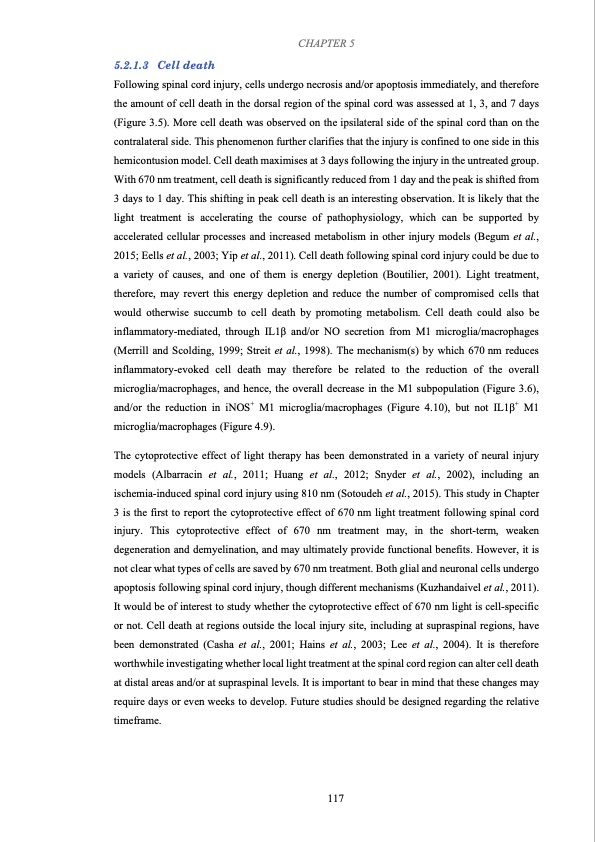
PDF Publication Title:
Text from PDF Page: 131
CHAPTER 5 5.2.1.3 Cell death Following spinal cord injury, cells undergo necrosis and/or apoptosis immediately, and therefore the amount of cell death in the dorsal region of the spinal cord was assessed at 1, 3, and 7 days (Figure 3.5). More cell death was observed on the ipsilateral side of the spinal cord than on the contralateral side. This phenomenon further clarifies that the injury is confined to one side in this hemicontusion model. Cell death maximises at 3 days following the injury in the untreated group. With 670 nm treatment, cell death is significantly reduced from 1 day and the peak is shifted from 3 days to 1 day. This shifting in peak cell death is an interesting observation. It is likely that the light treatment is accelerating the course of pathophysiology, which can be supported by accelerated cellular processes and increased metabolism in other injury models (Begum et al., 2015; Eells et al., 2003; Yip et al., 2011). Cell death following spinal cord injury could be due to a variety of causes, and one of them is energy depletion (Boutilier, 2001). Light treatment, therefore, may revert this energy depletion and reduce the number of compromised cells that would otherwise succumb to cell death by promoting metabolism. Cell death could also be inflammatory-mediated, through IL1β and/or NO secretion from M1 microglia/macrophages (Merrill and Scolding, 1999; Streit et al., 1998). The mechanism(s) by which 670 nm reduces inflammatory-evoked cell death may therefore be related to the reduction of the overall microglia/macrophages, and hence, the overall decrease in the M1 subpopulation (Figure 3.6), and/or the reduction in iNOS+ M1 microglia/macrophages (Figure 4.10), but not IL1β+ M1 microglia/macrophages (Figure 4.9). The cytoprotective effect of light therapy has been demonstrated in a variety of neural injury models (Albarracin et al., 2011; Huang et al., 2012; Snyder et al., 2002), including an ischemia-induced spinal cord injury using 810 nm (Sotoudeh et al., 2015). This study in Chapter 3 is the first to report the cytoprotective effect of 670 nm light treatment following spinal cord injury. This cytoprotective effect of 670 nm treatment may, in the short-term, weaken degeneration and demyelination, and may ultimately provide functional benefits. However, it is not clear what types of cells are saved by 670 nm treatment. Both glial and neuronal cells undergo apoptosis following spinal cord injury, though different mechanisms (Kuzhandaivel et al., 2011). It would be of interest to study whether the cytoprotective effect of 670 nm light is cell-specific or not. Cell death at regions outside the local injury site, including at supraspinal regions, have been demonstrated (Casha et al., 2001; Hains et al., 2003; Lee et al., 2004). It is therefore worthwhile investigating whether local light treatment at the spinal cord region can alter cell death at distal areas and/or at supraspinal levels. It is important to bear in mind that these changes may require days or even weeks to develop. Future studies should be designed regarding the relative timeframe. 117PDF Image | Effects of Red Light Treatment on Spinal Cord Injury

PDF Search Title:
Effects of Red Light Treatment on Spinal Cord InjuryOriginal File Name Searched:
Thesis_Di Hu_final.pdfDIY PDF Search: Google It | Yahoo | Bing
Cruise Ship Reviews | Luxury Resort | Jet | Yacht | and Travel Tech More Info
Cruising Review Topics and Articles More Info
Software based on Filemaker for the travel industry More Info
The Burgenstock Resort: Reviews on CruisingReview website... More Info
Resort Reviews: World Class resorts... More Info
The Riffelalp Resort: Reviews on CruisingReview website... More Info
| CONTACT TEL: 608-238-6001 Email: greg@cruisingreview.com | RSS | AMP |